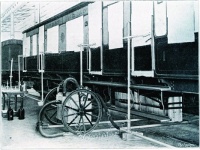
In the run-up to Christmas, commuters armed with sanitising gel and swine flu masks may well have welcomed a radical approach for disinfecting railway carriages reported in The Engineer’s archive. ’The method,’ said the article ’consists in generating a poisonous gas which is forced and circulated through the infected coach until every portion has been impregnated and the vermin or germs destroyed.’
Developed by Colonel Glen-Liston, a scientist at the Bombay Bacteriological Laboratory, the technique used hydrocyanic acid to disinfect an entire carriage within a 24-hour period. The Great Indian Peninsula Railway Company took on the system which the article describes as ’far in advance of anything that has so far been done in this direction’.
The components consisted of a portable gas generator, mounted on wheels, in which sulphuric acid and potassium cyanide were mixed using a 24-volt fan powered by the train’s lighting cells. This poisonous mixture was then ’propelled’ into the compartments of the carriage through piping. The vehicle was prepared by closing all windows and vents with paper and covering the entire carriage with tarpaulins.
Register now to continue reading
Thanks for visiting The Engineer. You’ve now reached your monthly limit of premium content. Register for free to unlock unlimited access to all of our premium content, as well as the latest technology news, industry opinion and special reports.
Benefits of registering
-
In-depth insights and coverage of key emerging trends
-
Unrestricted access to special reports throughout the year
-
Daily technology news delivered straight to your inbox










National Gas receives funding to develop Gravitricity underground hydrogen storage system
There can't possibly ever be a '<i>business</i>' case for the <i><b>bulk</b></i> storage of hydrogen, since Green hydrogen electrolysis...